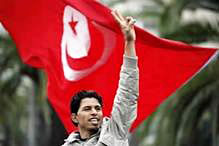Tunisia: the Jasmine Revolution, and the launch of the Arab Spring
2010[edit]
On 17th of December 2010, twenty-six year old Mohamed Bouazizi lit the match that ended his life in an act of self-immolation after his wheelbarrow stall full of fresh fruit produce was forcibly seized and he was beaten. His actions protesting against police interference and the lack of economic opportunities sparked what would become the Jasmine Revolution otherwise known as the Arab Spring.
Supported by an underground network of hackers, activists, and dissidents, protests escalated, and on 12 January a protest had spread to the capital of Tunis. The protesters were aided in part by connections with other non-violent protest movements in Ukraine and Serbia, who offered mentoring in the techniques of non-violent civil resistance.
The protesters rejected the incumbent President's, Zine el-Abidine Ben Ali, political and social concessions as "too little, too late", and on 14 January 2011, Ben Ali fled the country. Tunisian non-violent protesters had achieved non-violent coercion. The people of Tunisia helped to launch a wave of revolution throughout North Africa and the Middle East, conventionally termed the Arab Spring.
